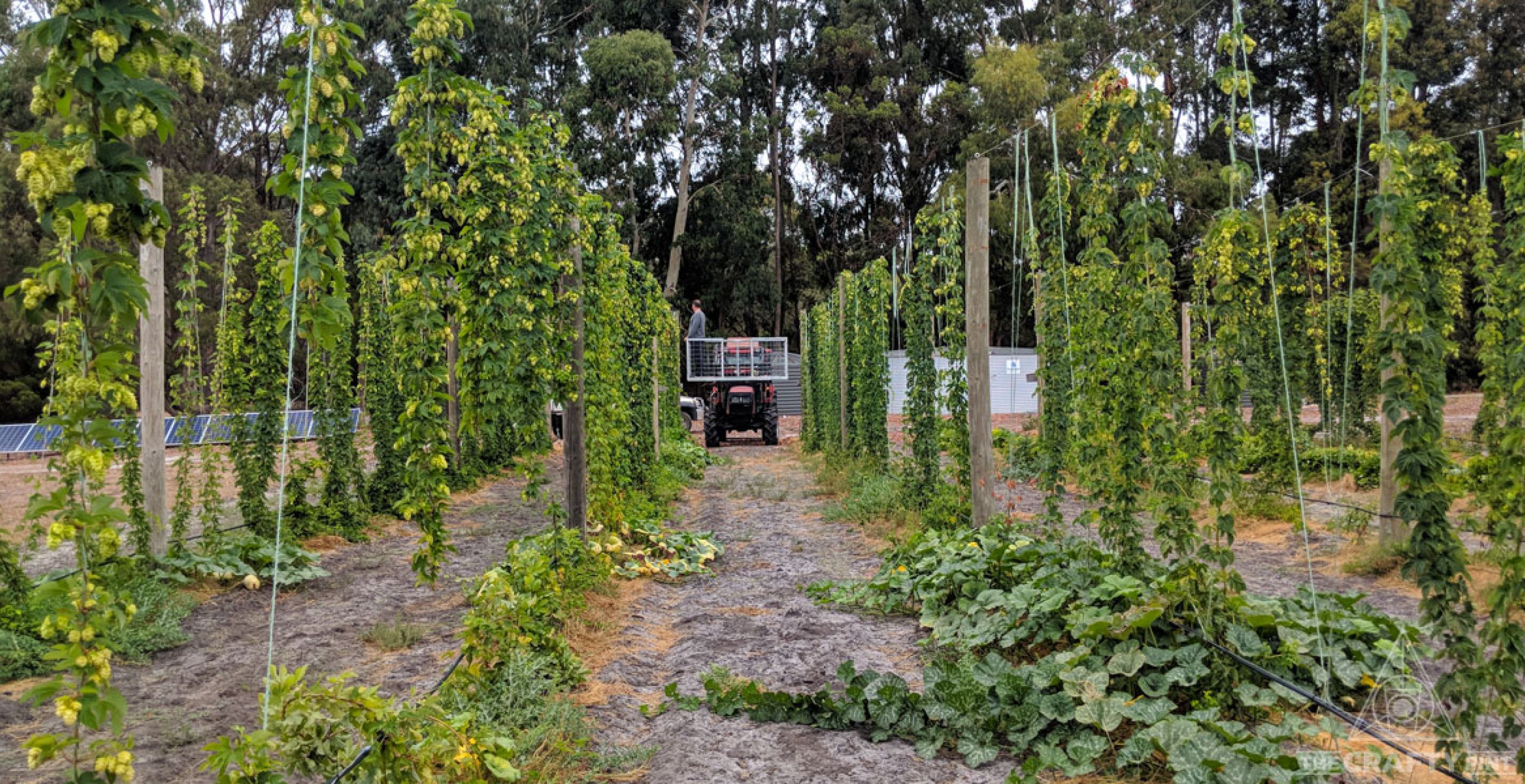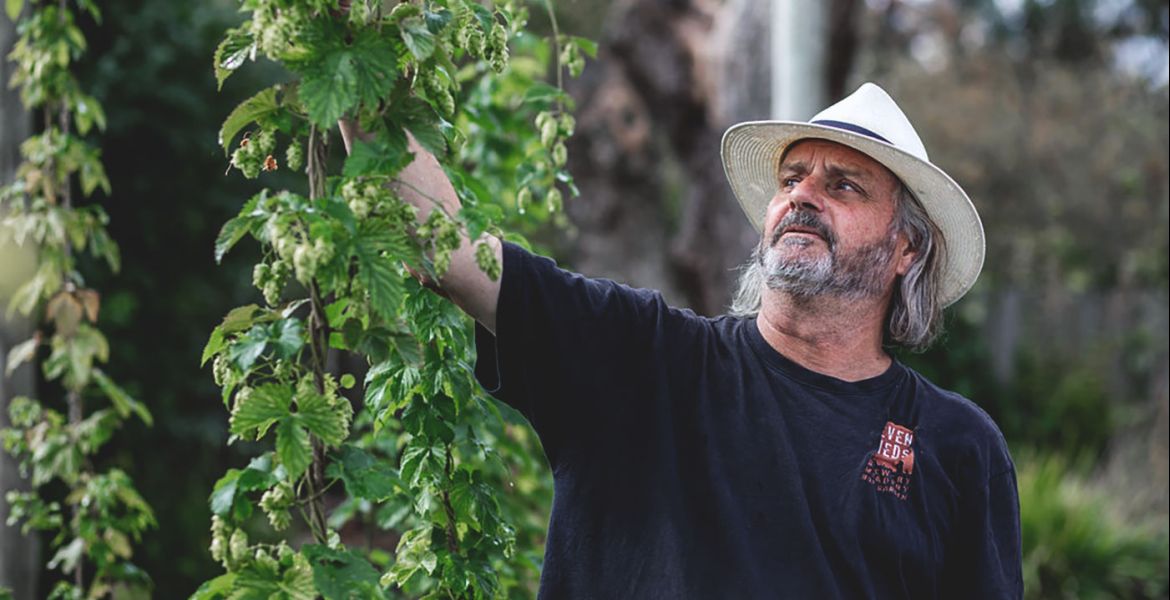Much like anything to do with beer, hop harvest at Karridale Cottages and Hop Farm brings together friends and family over a few good beers.
After my “normal” job finished on Friday, I drove south from Perth to Karridale, a town you’ll discover if you travel half an hour beyond its much better known big brother, Margaret River. In the dark, I found my studio cottage amongst the karri forest and settled in for a two-night stay.
Olivia Hertsted and Trey Gee have owned the Karridale property since January 2015. Both are originally from the US but have called Western Australia home for more than 15 years. They have a chocolate labrador called Fuggles, named after the English noble hop variety, and, late last year, they welcomed their baby girl Sonny into their lives.
The relaxation that comes with simply being in the south west must have hit hard as I slept through my alarm the following morning. Thankfully, I woke to a message from Olivia on my phone saying that, due to the morning rain, Trey was delaying the hop harvest until 10am.
“Perfect,” I typed back and went to find coffee and breakfast.
I first met Olivia and Trey just before their first hop harvest back in February 2016, a meeting that led to this Crafty Pint article. Two years later, it was good to be back, along with my dog, a kelpie named Barley, ready to get hands on with the hop harvest.
Cutting down the bines
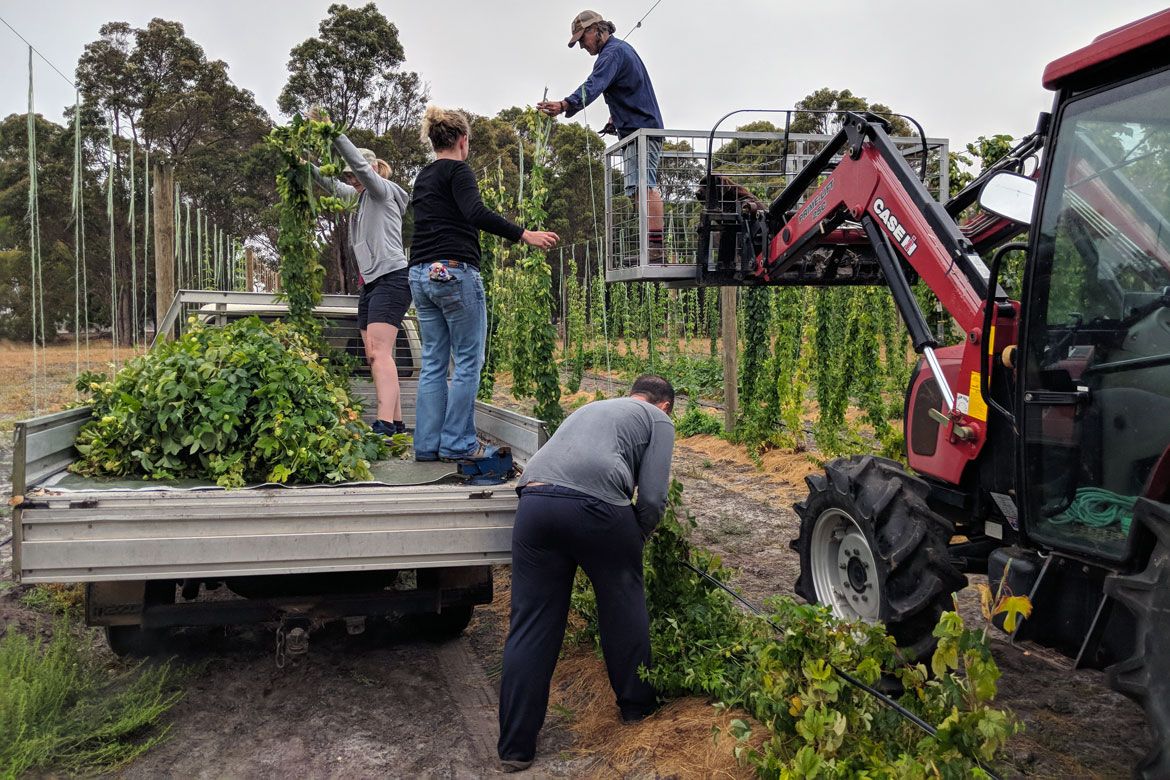
Trey had already identified the Pemberton Wild Blend hops ready for harvest by the time I find him in a large basket, accompanied by Fuggles, lifted by a tractor to the top of the bine (the name for the stem of the hop plant that, by harvest time, will have grown to several metres in height). He needs this elevation to be able to cut them from the top of the trellis. Having already cut the bines at the bottom, they're now completely detached, ready to be passed to eager helpers and loaded onto the back of his ute.
Because everything here is harvested by hand – in contrast to harvest at the country's larger hop farms operated by Hop Products Australia and Ellerslie Hop – a few of Trey and Olivia’s friends and family turn a weekend visit into a helping holiday. Trey says they have been looking into equipment but admits it's a massive investment. The machine they have been considering – the Hop Harvester 1000 – comes from New York and would set the couple back $12,000, and that's before you even get it out of the US. So, here, it's Human Harvester instead.
The Pemberton Wild Blend hop variety is their own and grew in Pemberton until the mid to late 70s. Trey went looking for the plant, found some growing wild and brought it back to Karridale. Though it’s likely derived from the Cluster and Fuggles family, they felt it made sense to give it a name that would give it provenance, hence Pemberton Wild Blend.
They are a call back to the Swan Brewery, who used the same variety, grown on a farm in Pemberton run by father and son, JJ and Arthur Bunn. In 1978, the Swan Brewery moved to Canning Vale and switched from using whole hop cones to pellets brought in from interstate; it wasn’t long before the Bunn's hop farm flickered out of existence.
Once the ute tray was almost full of cut hop bines, leaving enough room for everyone to (ahem) hop on the back (it was bound to happen), we rode back to the shed.
Tony, along with his wife Lorraine, manage the accommodation and property, and he is also helping out with harvest. He begins to detangle the hop bines and hand them to the rest of us to snip off the green gold: the lupulin rich cones. He is helped by Ken, the man behind the wheel of the ute, who, Trey tells me on the ride between farm and shed, built the original cottages on the property thirty years ago.
Hand harvesting hop cones
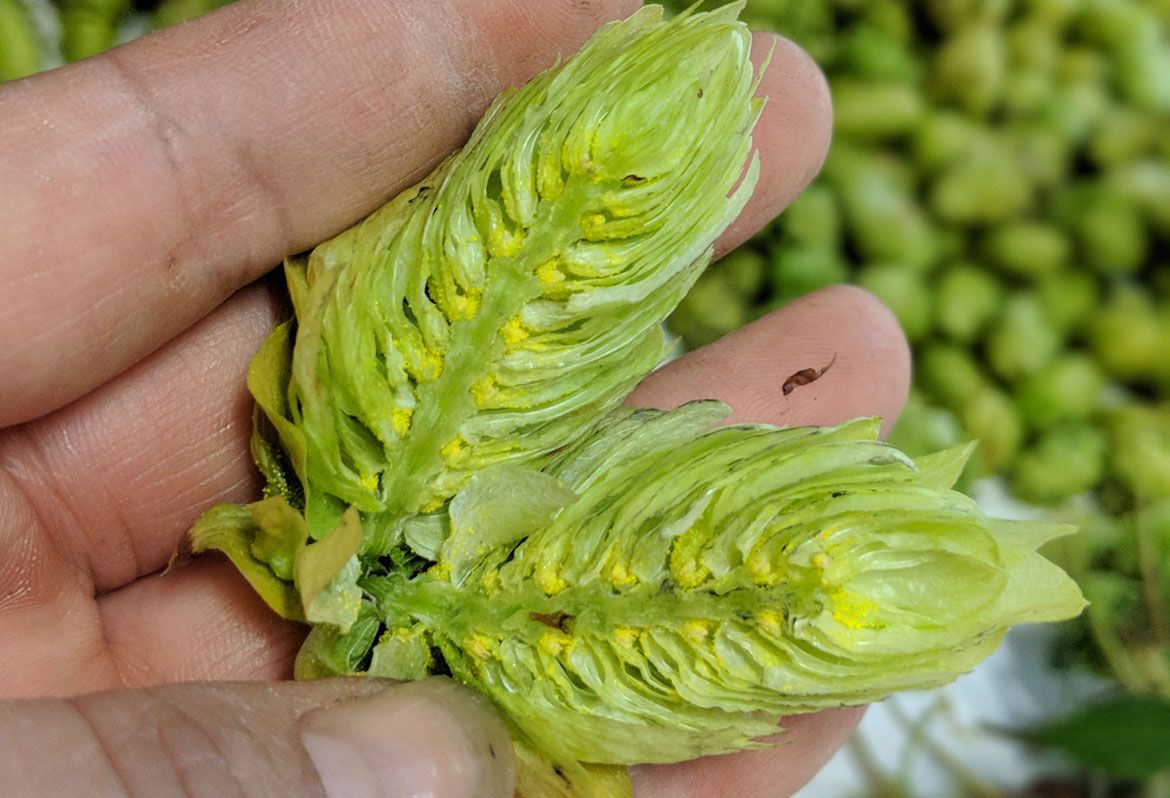
For those of us charged with cutting the hop cones from the bines, Trey guides us through the intricate, detailed instructions: cut the hop cones from the bines. It really is no more complicated than that.
“We leave as much stem on as possible because it weighs more,” he says, barely able to contain his laughter. He is, of course, kidding.
“What about these ones?” someone asks, holding up a bine with a few brown tinged cones.
“They’re fine,” Trey says. “It’s just a little wind burn; all the good stuff is inside.”
There are six of us, plus Trey, standing around a large table chatting and snipping while the pile of highly aromatic green cones in the middle of the table grows high and higher. Trey is probably chatting the most but that’s mainly because of my near-constant stream of questions.
He answers everything with enthusiasm, knowledge and passion. For a guy who still has a day job teaching in Perth four days a week and a two-month-old daughter, his energy levels are surprisingly high.
Occasionally, Trey holds up a particularly beautiful hop cone, drawing everyone’s attention to it, perhaps cutting it open with one squeeze of his gardening snips, and smiling in delight at the smell. Everyone seems to get something different from the Pemberton Wild hops: someone says minty but it comes across to me more as honeydew melon and a little grassiness.
Drying the cones
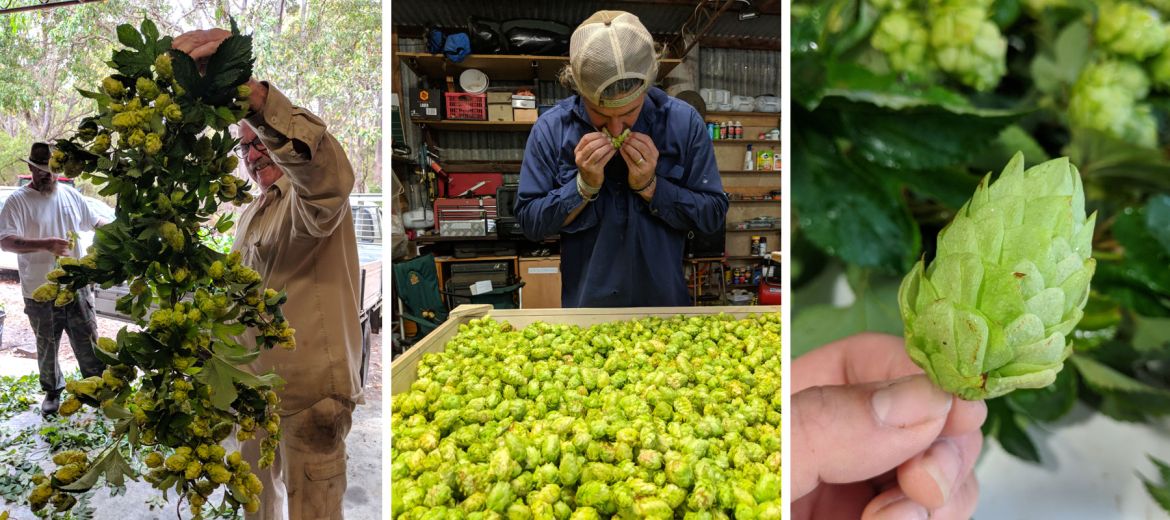
Just as the pile in the middle of the table is threatening to take over the whole space, Trey pulls out a large tray they use for drying the hop cones. It's about 1.3 metres long, just shy of a metre wide and no more than a hand length deep. The frame is made from ply and has a wire bottom, which allows hot air to circulate through the hops.
The tray slides into a cabinet with heaters in the bottom and extractor fans in the top, pulling a constant stream of hot air through the trays. A temperature probe sits in a tray in the middle of the cabinet and the regulator it’s attached to is set to max out at 40 degrees.
The cabinet and trays are all handmade – a simple construction – that does exactly what they need it to do.
We position the tray under the edge of the table and begin to slide the hop cones in, spreading them in an even layer that covers the wire base. Trey explains that we neither want too many in each tray nor too few, thus leaving gaps – both will result in uneven drying. Just like everything in beer, there’s a balance between too much and not enough.
“They’re 70 percent water content right now and you need to get that down to seven percent,” says Trey.
I’m crazy happy as I move my hands through the hop cones and, again, every so often Trey spots a great looking one and can’t resist picking it up and showing it off.
Once the tray is full, we slide it into the cabinet, Trey writes: “Pemberton 17/2” on the front in blue chalk and we close the door. That’s the first of nine trays we will have at the end of the day.
It’s been a couple of hours and we’ve finished the first load, Trey checks to see if everyone wants to keep going and is met by a resounding "Yes!" so we pile onto the back of the ute once more, not forgetting Fuggles and Barley, and head back to the hop yard.
Back to the hop yard

I walk with Trey as he cuts the bottom of the bines and notice he’s not cutting all the way to the base. He says they cut the bines right back to the base during their first hop harvest but, later that year, he and Olivia took a trip to France and, after visiting some hop farms there, learnt to cut a little higher: just under the spot where the plant starts growing cones.
The reason for this is the plant continues to live and grow for another couple of months until winter, at which point they’ll need to cut the bines right back. But until then the plant still needs to photosynthesise in order to keep growing. Trey refers to their France trip a number of times over the day: aside from being a pretty delightful tax write-off, it was a trip that provided valuable learnings for them as hop farmers.
After all, says Trey: “You can only get so much from books.”
As we walk through the yard, Trey points out the mix of one-, two- and three-year-old bines, and the differences in how they’re growing. Large sections of Cascade are thriving, throwing off crowded bunches of hop cones, and the bines are dense; there's so many on one twine you can’t see daylight through them. The aim is for all hop varieties to grow like this.
Trey grabs another good looking cone that he holds up as an excellent example of a Cascade hop cone and this time I make him stop for a photo.

The Hallertau hops, which local brewery Cheeky Monkey has already put dibs on, are close but not quite ready, Trey says. He gently squeezes the hop cones, looking for what he describes as a “papery” texture that tells him they’re ready for harvest. He’s confident the Hallertau will be ready by the time Ross, Cheeky Monkey’s head brewer, drops by next week.
While the back of the ute fills with more cut hop bines, I grab the opportunity to take a lot of photos: close up it’s easy to see the difference between the varieties. The Cascade cones are longer, more pointy at their ends, while Nugget's are shorter and kinda plump, living up to their name. The Perle cones, which we were harvesting next, are also compact and short, their leaves flaring out a little at the ends.
With the Perle loaded onto the ute, we drive back to the shed to start again. Soon, there are small cups of Trey’s homebrew being poured. There’s a choice between a lager, a mulberry sour and a pale ale. Most people go for the pale ale but I can’t resist the mulberry sour, which hits the spot with restrained tartness and a dry finish.
More snipping, more chatter, more music and more hops... The next few hours fly by, a couple more people drop in and soon we've filled a total of nine trays with hops. With each tray that is filled, we take the opportunity to rotate them in the cabinet, moving each one down a spot, and, each time we do this, we rustle through the hops to turn them all individually too.
Mould is the biggest concern when it comes to drying the hop cones, hence the heavy rotation to ensure even drying. When the cabinet is full, between beers and banter, every hour or so we rotate everything again. We open some beers: hoppy beers, farmhouse beers and sours, they’re all there; there’s even a few Emu Exports kicking around. It’s a good way to finish the day.
It’s not until I leave the shed to fetch more beer that I realise how much I’d adapted to the smell of fresh hops. Walking back into the shed, the aromas smack you in the face: fresh cut grass, soft spice and floral aromatics.
Talk of dinner leads to a BBQ in the shed, made up of one salad and four different meats, including some Boerewors, a South African sausage purchased from “the guy at the corner at the servo”; under normal circumstances, I might found that a little frightening, but I'm assured it’s okay and, of course, it is.
Beer, food and rotating the hops continues for a while. The hops will stay in overnight and, when they’re ready, Trey will pack them for the breweries to grab them.
The vast majority of Karridale's hops are allocated before harvest even starts. And they're all destined for West Australian breweries – the likes of Cheeky Monkey, Gage Roads and Bootleg Brewery, to name a few, are all planning beers showcasing Trey and Olivia’s hops. Some brewers are taking them as wet hops, freshly plucked from the bine for use in the boil straight away, while others have requested dried whole cones instead. Most, if not all, are destined to be used as late boil aromatic hop additions but, in time, Trey says he’d love to see beers made with nothing by Karridale hops used for both bittering and aroma.
The Future

Harvest will continue for a couple more weeks through March as each variety reaches readiness at slightly different times. Most of the Cascade was harvested first, with cones picked and dried and samples sent to Missouri for analysis. It’s the off-season for hop farmers in the United States so this is the cheapest way for the couple to get their hops analysed.
The results from their first year of harvest bought back some interesting results, particularly with Cascade, an iconic American hop variety that is the defining character of many classic pale ales, none more so than Sierra Nevada's. The variety, known as one of the American hop industry's three C’s American hops (along with Chinook and Columbus), typically contains alpha acids (which contribute bitterness to beer) between about five to seven percent, depending on where you get them. But the Cascade from Karridale tested at 11.5 percent, effectively making them "Super Cascade".
“Maybe it’s the terroir," Trey speculates. "It’s not hot but it gets plenty of sun.”
Aaron Davy from Preston Valley Hops in Queenwood, about an hour and a half from Karridale, is teaming up with a local professional nursery to experiment with cloning instead of using rhizomes and Trey will be jumping in to play around with them as they look to expand their yard too. Rhizomes – small roots cut from a hop plant – only have a 70 to 80 percent strike rate but cloning, which means using rooting hormones with the right cutting from the plant under nursery conditions, could potentially mean an improved strike rate and a yield in the first year because the root structure is already there.
There are also plans to expand the yard again, adding more rows to the hop yard but, instead of matching the 3.5 metre height of the existing poles, they’ll be erecting taller ones that will allow the bines to grow to 5.5 metres. They can intall taller trellises because they now have the tractor to lift them higher; the outcome, hopefully, will be a larger yield from their bines.
They are currently growing thirteen varieties at Karridale, and this year they introduced Victoria, a variety once cut from Hop Products Australia's development program, kept alive by a few homebrewers and more recently brought into small scale commercial production once more by Brad Merritt at Yellingbo, east of Melbourne. They will soon add Centennial, another well known American variety, and, in longer terms plans, Trey also wants to host hop harvest weekends during which visitors can pick and use cones in their own beer, brewed on site on the day. Then, when the beer is ready, it can be delivered to them up in Perth.
But that’s a way off. For now, it’s all about finishing this, their third, harvest. And, of course, looking forward to drinking delicious local beers from the breweries who’ve bought their hops.

